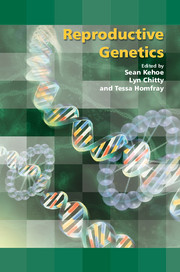Book contents
- Frontmatter
- Contents
- Participants
- Declarations of personal interest
- Preface
- 1 Genetic aetiology of infertility
- 2 Disorders of sex development
- 3 Preimplantation genetic diagnosis: current practice and future possibilities
- 4 Ethical aspects of saviour siblings: procreative reasons and the treatment of children
- 5 Epigenetics, assisted reproductive technologies and growth restriction
- 6 Fetal stem cell therapy
- 7 Prenatal gene therapy
- 8 Ethical aspects of stem cell therapy and gene therapy
- 9 Fetal dysmorphology: the role of the geneticist in the fetal medicine unit in targeting diagnostic tests
- 10 Fetal karyotyping: what should we be offering and how?
- 11 Non-invasive prenatal diagnosis: the future of prenatal genetic diagnosis?
- 12 Non-invasive prenatal diagnosis for fetal blood group status
- 13 Selective termination of pregnancy and preimplantation genetic diagnosis: some ethical issues in the interpretation of the legal criteria
- 14 Implementation and auditing of new genetics and tests: translating genetic tests into practice in the NHS
- 15 New advances in prenatal genetic testing: the parent perspective
- 16 Informed consent: what should we be doing?
- 17 Consensus views arising from the 57th Study Group: Reproductive Genetics
- Index
1 - Genetic aetiology of infertility
Published online by Cambridge University Press: 05 February 2014
- Frontmatter
- Contents
- Participants
- Declarations of personal interest
- Preface
- 1 Genetic aetiology of infertility
- 2 Disorders of sex development
- 3 Preimplantation genetic diagnosis: current practice and future possibilities
- 4 Ethical aspects of saviour siblings: procreative reasons and the treatment of children
- 5 Epigenetics, assisted reproductive technologies and growth restriction
- 6 Fetal stem cell therapy
- 7 Prenatal gene therapy
- 8 Ethical aspects of stem cell therapy and gene therapy
- 9 Fetal dysmorphology: the role of the geneticist in the fetal medicine unit in targeting diagnostic tests
- 10 Fetal karyotyping: what should we be offering and how?
- 11 Non-invasive prenatal diagnosis: the future of prenatal genetic diagnosis?
- 12 Non-invasive prenatal diagnosis for fetal blood group status
- 13 Selective termination of pregnancy and preimplantation genetic diagnosis: some ethical issues in the interpretation of the legal criteria
- 14 Implementation and auditing of new genetics and tests: translating genetic tests into practice in the NHS
- 15 New advances in prenatal genetic testing: the parent perspective
- 16 Informed consent: what should we be doing?
- 17 Consensus views arising from the 57th Study Group: Reproductive Genetics
- Index
Summary
Introduction
In recent years there has been increasing concern about a possible decline in reproductive health. It is estimated that one in seven couples worldwide have problems conceiving and there is increasing demand for fertility treatments. These include intracytoplasmic sperm injection (ICSI) and in vitro fertilisation. In some European countries, such as Denmark, more than 6% of children are born after assisted reproduction. Sperm counts in many European countries are declining by around 2% per year.
Although human infertility rates are high and increasing, our understanding of the genetic pathways and basic molecular mechanisms involved in gonadal development and function is limited. In this overview, we examine the various forms of infertility and the evidence that there is a genetic component, and discuss in some detail the known genetic causes of infertility.
Female infertility
The main causes of female infertility are anovulation and anatomical causes such as obstruction in the genital tract (ovulatory infertility). About one-third of all cases of female infertility are due to obstruction in the genital tract. The obstruction can be in the fallopian tubes, uterus, cervix or vagina. Uterine abnormalities include congenitally absent (Mayer–Rokitansky–Küster–Hauser [MRKH] syndrome), bicornuate or double uterus, leiomyomas and Asherman syndrome.
Endometriosis is an estrogen-dependent inflammatory disease that affects 5–10% of women of reproductive age in the USA. Its defining feature is the presence of endometrium-like tissue in sites outside the uterine cavity, primarily on the pelvic peritoneum and ovaries.
Keywords
- Type
- Chapter
- Information
- Reproductive Genetics , pp. 1 - 14Publisher: Cambridge University PressPrint publication year: 2009

